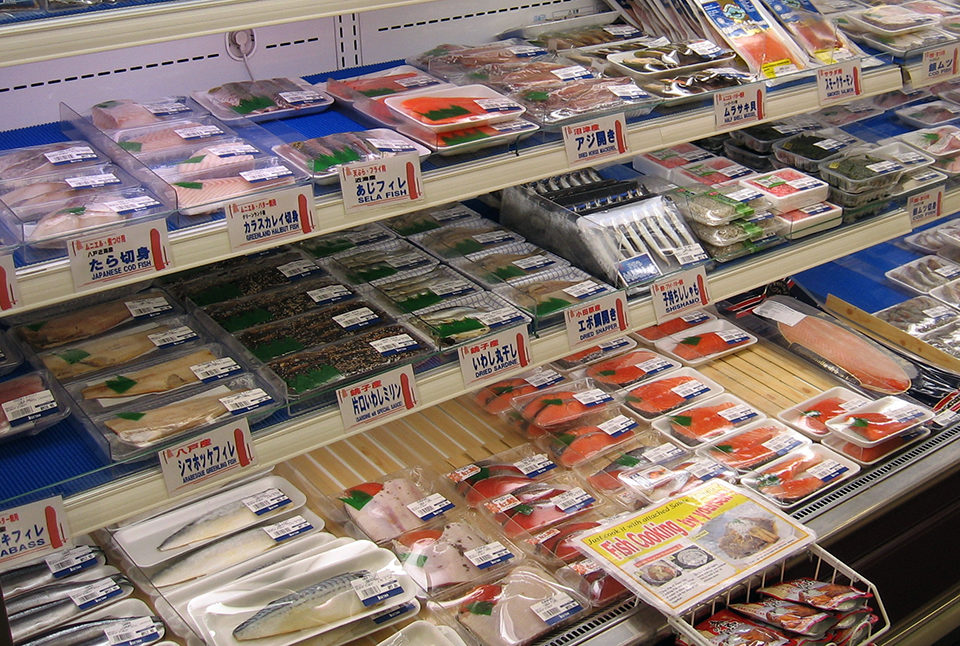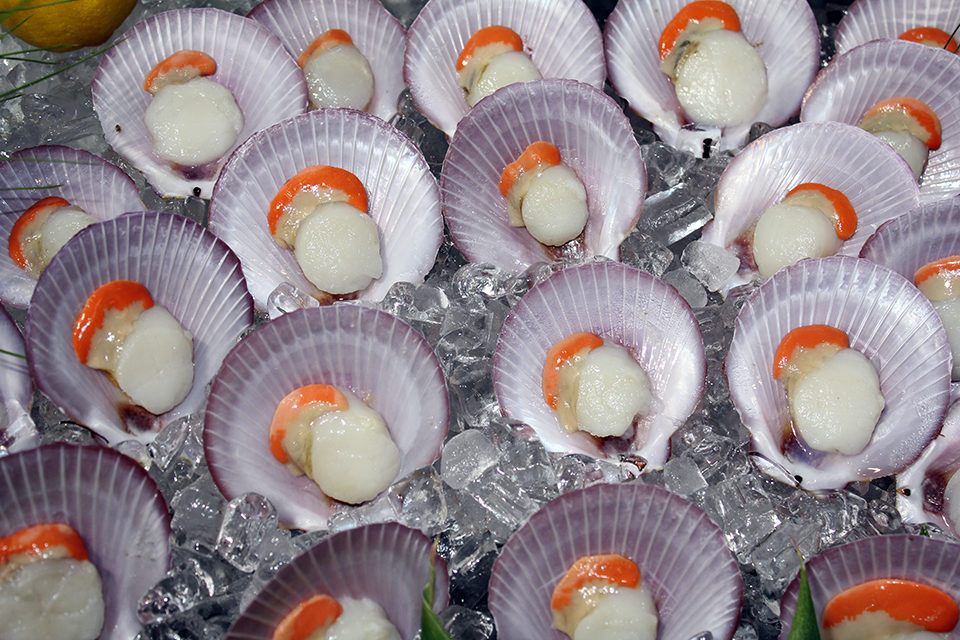Global campaigns promote seafood

Campaigns focused on the health benefits of seafood consumption are regularly implemented around the world. Anna Child, an international consultant in the Products, Trade and Marketing Service of FAO Globefish, outlined a list of activities around the world that includes promotional fairs and pro-seafood campaigns of various types. Most incorporated education as well as promotion.
‘Slow fish’ in Italy
Some events are especially designed for children, many of which are strongly related to fishing rather than aquaculture. For example, Slow Fish in Genoa, Italy, has been running since 2007 and includes activities on fish designed specifically for children, as these young consumers are often unfamiliar with seafood and how it comes to be on a plate.
The fairs displayed a variety of educational modules through which young consumers could learn about fish and fishing. The children also received hands-on experience about cooking and eating underutilized fish species like horse mackerel and blotched picarel. Educational resources such as guides, games and small aprons with the fish seasons on it were distributed.
Fish week in Brazil
The Brazilian Association of Supermarkets and the Ministry of Fisheries and Aquaculture in Brazil have been collaborating to hold an annual Fish Week. The event aims to market the health benefits of fish consumption to Brazilian consumers through a large promotional campaign and discounted fish prices. In 2009, more than 300 supermarkets joined the event.
One facet of the program was to convince companies to slightly reduce their profit margins to obtain stronger and more long-term partnerships with markets and consumers. Supermarkets that participated in 2008 experienced a greater than 30 percent increase in their sales of fish and other categories of complementary products during the promotion period. In Brazil, seafood consumption was only about 5 kg/capita. The Brazilian government made a number of decisions, not the least of which was the opportunity to farm tilapia. Tilapia production went from zero to 200,000 mt in five years, and not surprisingly, seafood consumption in Brazil is now around 9 kg/capita.
El Salvador campaign
A joint campaign by the Food and Agriculture Organization of the United Nations and El Salvador’s Ministry of Agriculture disseminated attractive and easy-to-read materials promoting seafood’s health benefits, marketing fish as a “source of life” with “the nutrition that you need” and recommending eating seafood at least twice a week. The materials also provided helpful tips for home fish consumption. The project was called “Feed Your Stomach and Your Brain,” and a number of promotional materials were created.

Indonesian fairs
It is very important to get the seafood story out to young women, the mothers of the future. To that end, in 2011, the Indonesia Marine and Fisheries Ministry began holding a series of promotional fairs on the benefits of consuming fish, specifically targeting pregnant mothers.
These events were part of a government program aimed at increasing fish consumption nationwide. National annual fish consumption in 2010 was 30.47 kg/capita, but the government hopes to raise the figure to 38.00 kg by 2014.
The Indonesian maritime affairs and fisheries minister, Fadel Muhammad, said the government targeted pregnant mothers for the campaign because survey results found that many Indonesian children lacked omega-3s in their diets. The fatty acids are thought to strengthen infants’ immune systems and prospects for healthy growth. Promotional fairs were held in villages across the country using local languages.
Bangladesh national fisheries week
Countries like Bangladesh understand the importance of seafood. In July of 2011, a National Fisheries Week was inaugurated in Bangladesh with a target to produce 3.5 million metric tons (MT) of fish by the end of 2013 and 4.2 million MT by the end of 2021. This is seen as a significant step toward Bangladesh achieving food security and sovereignty. Currently, the fish sector supplies 60 percent of the country’s animal protein, 3 percent of export earnings and nearly 4 percent of the total gross domestic product.
The 2011 National Fisheries Week theme was “Produce Safe Fish to Change Bangladesh.” The Fisheries and Livestock Ministry provided support with workshops and technical training. The week also aimed to increase awareness of fish in citizens through fish fairs, publication of supplementary information in national newspapers, telecasts, essay writing and a painting competition.
Poland: Mr. Carp
Following investments in seafood promotion made by the Czechs, Poland created the “Mr. Carp Campaign.” The Inland Fisheries Institute in Olsztyn and the Fish Promotion Society conducted a promotional campaign for carp, the most traditional Polish aquaculture product. The campaign was largely a result of carp breeders facing growing competition from outside the European Union. Supported with funds from the E.U., the campaign sought to reassert carp’s position in the market.
Denmark’s twice a week
The Seafish Authority in the United Kingdom and the Danish government have both emphasized the “Twice a Week” approach.
When it was discovered that Danes do not eat enough fish, a campaign was coordinated by Fiskebranchen, an umbrella organization that brings together players in the fisheries and aquaculture sectors. In order to make the campaign successful, efforts were coordinated among the seafood industry, Denmark’s Technical University, the Heart Foundation and most importantly, the retail segment.
Formative work by researchers from the university and the Danish Heart Foundation demonstrated several specific reasons for consumers not eating enough fish. These included the perception that fish was difficult to prepare and not readily available, as well as a lack of clarity about the amounts to eat and its benefits.
From this formative work, specific campaign messages were developed to achieve objectives, such as familiarizing consumers with the dietary advice of the Danish Veterinary Food Administration and encouraging retail chains to increase the range of fish sold. The campaign also sought to increase overall seafood consumption by educating consumers that fish is tasty and easy to prepare and motivating consumers to change their consumption habits.
A website was developed to provide information about fish, including two new recipes each week. A link on the website allowed users to sign up for a weekly newsletter that would include recipes, and there are now over 52,000 subscribers. A cookbook with simple recipes for daily cooking and special occasions proved to be quite popular, with 1.7 million copies printed and distributed. Organizers noted that the most difficult part of the campaign was increasing awareness about the availability of fish and getting retailers to reduce their prices.
Researchers who analyzed the impacts of the campaign found that fish consumption, in fact, increased. They found that in 2009, sales of fish had increased by 14,000 metric tons and €21.5 million from pre-promotion levels in 2005, although some of the increase in value could be attributed to price increases for fish of over 20 percent between 2005 and 2009.
The analysis also found the campaign increased the visibility of fish at retailers, in discount catalogs, on the Internet and in public spaces, with consumers having more experience selecting and cooking fish. Lastly, the analysis concluded that the main existing barrier to fish consumption was that consumers still regarded fish as expensive.
The Twice a Week logo was widely used by producers, retailers and fishmongers and in all the promotional material. After running the campaign for two years, the logo was recognized by 76 percent of the population in Denmark.
Perspectives
These examples show that campaigns and promotions on seafood can be very successful. Many of them include governments working with industry and other institutions, and clearly they focus on the strengths of the benefits of seafood.
We need to challenge our own governments to get involved and follow these successful concepts. If we do that, we will not only make the world a healthier place, but also assist in creating more jobs and opportunities for young people. Let us work together on this.
(Editor’s Note: This article was originally published in the May/June 2013 print edition of the Global Aquaculture Advocate.)
Author
-

Roy D. Palmer, FAICD
GILLS
2312/80 Clarendon Street
Southbank VIC 3006 Australia
www.gillseafood.com
Related Posts

Health & Welfare
A look at tilapia aquaculture in Ghana
Aquaculture in Ghana has overcome its historic fits and starts and is helping to narrow the gap between domestic seafood production and consumption. Production is based on Nile tilapia.

Responsibility
A look at unit processes in RAS systems
The ability to maintain adequate oxygen levels can be a limiting factor in carrying capacities for RAS. The amount of oxygen required is largely dictated by the feed rate and length of time waste solids remain within the systems.

Intelligence
Adding value to tilapia to tap into U.S. market
New markets for tilapia and expansion of existing ones can be created by planning and implementing properly designed geographic strategies to meet discriminating consumer preferences. Low labor costs in most producing countries promotes value-adding by the production of fresh fillets.

Health & Welfare
Aiding gut health with a natural growth promotor
A study with Nile tilapia conducted in commercial production cages in Brazil showed the potential – in the absence of major disease threats – of a commercial, natural growth promotor that modulates the microbiota (inhibiting growth of pathogenic bacteria and promoting growth of beneficial bacteria) and inhibits quorum sensing.

